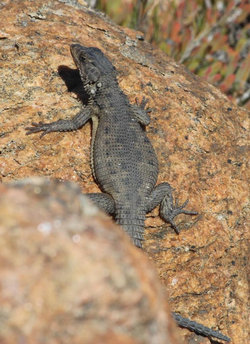Biology:Karusasaurus polyzonus
| Karusasaurus polyzonus | |
|---|---|

| |

| |
| Scientific classification | |
| Domain: | Eukaryota |
| Kingdom: | Animalia |
| Phylum: | Chordata |
| Class: | Reptilia |
| Order: | Squamata |
| Family: | Cordylidae |
| Genus: | Karusasaurus |
| Species: | K. polyzonus
|
| Binomial name | |
| Karusasaurus polyzonus (Smith, 1838)
| |
| Synonyms | |
| |
Karusasaurus polyzonus, commonly known as the Karoo girdled lizard or the southern karusa lizard, is a species of lizard in the family Cordylidae.
Etymology
Karusasaurus, the genus name, is derived from the Khosian word "Karusa" and the Latinized Greek word "saurus." Karusa translates to "dry" or "barren," and "saurus" translates to "lizard."[3]
Description
The Karoo girdled lizard is a rather large species. Its distance from its snout to its cloaca (known as snout-to-vent length) is roughly 120 millimeters, which is nearly 5 inches. It has osteoderms distributed throughout its body.[3] It varies greatly in color – specimens range from black, red, to turquoise. Individuals can also be spotted.[4][5]
Distribution and ecology
The Karoo girdled lizard is a common species, distributed throughout the southern part of Africa. Specifically, it occurs in Southern Namibia, and most of South Africa . Specimens have also been recorded in other nearby areas, but these have not been confirmed. It covers an area of almost 150,000 square kilometers in total.[1]
The Karoo girdled lizard almost always dwells in rocky areas – besides that, their habitat varies somewhat. It occurs at lower elevations – specimens have been found mostly in lowland areas as well as on the lower slopes of mountains.
This lizard species is ovoviviparous, which means that the eggs the embryos are in stay inside their mother's body until they are ready to hatch.[3] Its generation time is over a year, which is known as semivoltinism. It is diurnal, and is dormant during certain seasons.[2] Like Karusasaurus jordani, it is an insectivore.[4]
References
- ↑ 1.0 1.1 Mouton, P.L.F.N. (2018). "Karusasaurus polyzonus". IUCN Red List of Threatened Species 2018: e.T110161123A115675844. doi:10.2305/IUCN.UK.2018-2.RLTS.T110161123A115675844.en. https://www.iucnredlist.org/species/110161123/115675844. Retrieved 12 November 2021.
- ↑ 2.0 2.1 J., Irish. "Karoo Girdled Lizard, Karusasaurus polyzonus in Namibia". http://biodiversity.org.na/taxondisplay.php?nr=1846.
- ↑ 3.0 3.1 3.2 Uetz, Peter; Hallermann, Jakob. "Karusasaurus polyzonus". http://reptile-database.reptarium.cz/species?genus=Karusasaurus&species=polyzonus.
- ↑ 4.0 4.1 "Karoo Girdled Lizard (Karusasaurus polyzonus)". https://www.inaturalist.org/taxa/33061-Karusasaurus-polyzonus.
- ↑ Stanley, Edward. "Girdled lizards". https://www.edwardstanley.org/girdled-lizards.html.
Wikidata ☰ Q3193630 entry
 |


